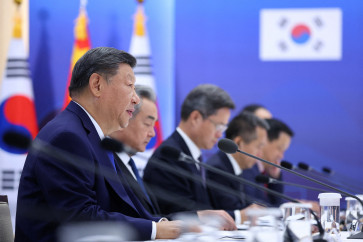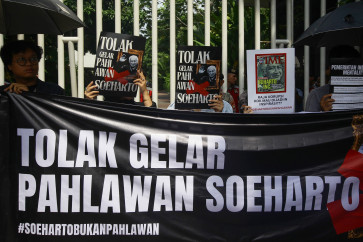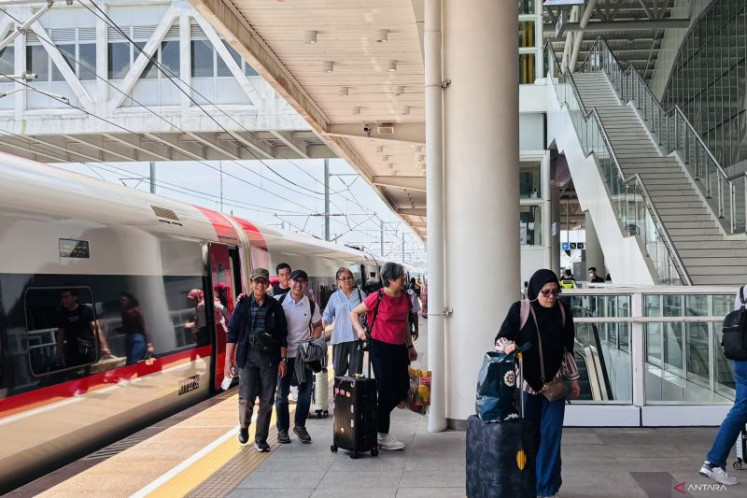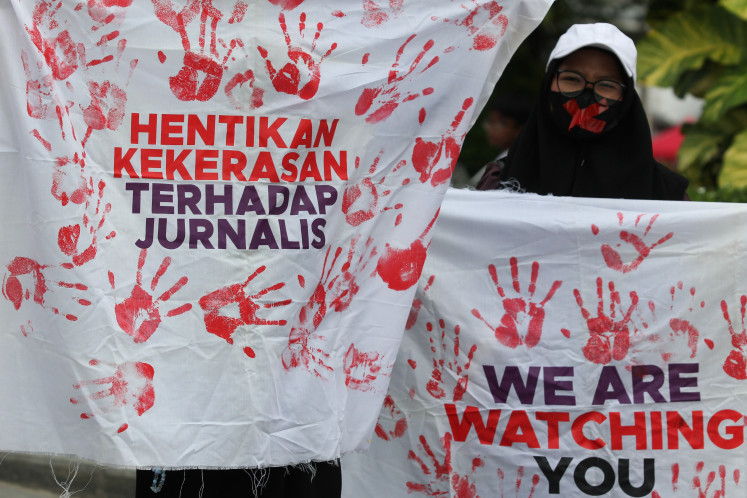Popular Reads
Top Results
Can't find what you're looking for?
View all search resultsPopular Reads
Top Results
Can't find what you're looking for?
View all search resultsPita Prada celebrates traditional Balinese paintings
Pemilihan presiden (Presidential election) by Ketut Sadia
Change text size
Gift Premium Articles
to Anyone
Pemilihan presiden (Presidential election) by Ketut Sadia. JP/I Wayan Juniartha
Painting connoisseurs who find themselves stranded in Ubud this month should not curse their fate.
Yes, the seemingly eternal traffic jams, the overzealous street hawkers and the hordes upon hordes of noisy visitors tend to make this little town a suffocating place to get lost in.
However, for lovers of good paintings, the town currently offers a rare feast for the eyes: the first biennale of traditional Balinese paintings, featuring more than 150 paintings, including masterpieces from the past and breathtaking works from the present.
“Pita Prada” (Golden Creativity), an obvious homage to Pita Maha (Great Creativity), the group of influential Ubud painters from the late 1930s whose works marked the birth of traditional Balinese painting, the biennale takes place at three of Ubud’s finest art museums: the Neka Arts Museum (NAM) in Sanggingan, the Puri Lukisan Museum in downtown Ubud, and the Agung Rai Museum of Arts (ARMA) in Pengosekan.
The biennale features the works of 113 painters, from those who achieved greatness in the 1940s to young painters of the modern era.
“This biennale reflects the aesthetic achievements of three generations of Balinese painters, who steadfastly preserved and developed the traditional styles,” says Bali Bangkit chairman Jusuf Wanandi.
Bali Bangkit, an organization of private collectors and concerned individuals interested in conserving and advancing the island’s traditional fine arts, is the primary organizer of the biennale. Earlier this year, Bali Bangkit organized the “Siyu Taksu” (A Thousand Spirits) exhibition of traditional Balinese paintings in Jakarta.
Bali Governor Made Mangku Pastika, who officially opened the biennale on Dec. 11, praised Bali Bangkit as a congregation of individuals who loved Bali more than most Balinese ever did. The biennale, Pastika went on, was a commendable undertaking.
“I understand this is a very difficult undertaking. Compiling hundreds of works from different collectors and institutions is no easy task,” he said.
“Naturally I would like to extend my gratitude to these people who have worked so hard and are so committed in ensuring that traditional Balinese paintings do not fade into obscurity.”
Memperebutkan tirta abadi (Quarrelling over eternal water) by Ketut Ginarsa. JP/I Wayan Juniartha
Obscurity perhaps best illustrates the state of traditional Balinese paintings and painters over the last decade.
As the art market’s preference shifts to bold, contemporary works, the island has seen a boom in new, modern galleries with a uniform taste for avant-garde works, drawing a large number of Bali’s young painters into contemporary styles that are more rewarding, financially and aesthetically, and gradually phasing the island’s traditional paintings out of the public’s consciousness.
Art critic Jean Couteau blames the decline on a number of concomitant causes.
“The first reason is to be found in the competitive encounter of Bali style and modern style of paintings,” he says.
For a long time Balinese village painters were almost exclusively those in the Ubud area. From the 1970s, the number of non-Balinese artists in the Ubud area, some fo-reigners but mostly non-Balinese Indonesians, increased steadily. Before long there were two types of paintings on the market: traditional Balinese paintings and modern non-Balinese Indonesian paintings. Du-ring the late 1970s and early 1980s, the two types grew up side by side.
Gradually, however, the differences in production between the two, and the consequences for price and marketing, saw the modern type eclipse the traditional.
“Traditional Balinese painting requires painstaking attention in the production process and consumes a large amount of time, measured in weeks or even months,” Couteau says.
“Its making requires a succession of complex technical phases – drawing, layering of ink wash, coloring.
Pagi hari di pulau surgawi (Morning in the island of heaven) by GA Wiranata. JP/I Wayan Juniartha
“Modern painting, on the contrary, requires much less labor, attention and time, making it possible to complete an artwork in only a few hours,” he goes on, adding the situation has contributed to modern painters being able to offer a more competitive price for their works.
Price, Couteau adds, is not the only force driving traditional paintings into obscurity. The other factor is its aesthetic.
“Balinese traditional artists often use esoteric symbols and narratives known only to themselves,” he says.
“Such an art is not easily accessible. It requires an anthropological kind of curiosity, a readiness to accept differences in regard to aesthetic as well as themes. Only ‘cultured’ people have such readiness.
“Appreciating paintings made by non-Balinese modernists is by comparison much easier. The view they give of Bali is an ‘outsider’s view’, like that of ordinary tourists.”
The third factor is the introduction of TV and modern education, which according to Couteau, has significantly altered the ways the Balinese see the world around them, and consequently changed the ways they visualize it.
But obscurity is by no means extinction. The faithful stewards of traditional styles continue producing works in that style. Some merely “reproduce” the styles and themes of the old masters, while others infuse the old style with the vibrancy, colors and themes of the contemporary world.
“The realm of traditional Balinese painting is a vivid, dynamic landscape filled with joie de vivre,” says Wanandi.
“In the last couple of years we saw the emergence of so many talented young artists who created excellent works in this style. For instance, in a small village of Keliki alone there are around 200 painters.”
He adds passionately that these young painters need a powerful medium to regain their place in the public’s consciousness.
The biennale is seen as the perfect vehicle for that purpose.
“The biennale will serve as testimony that traditional Balinese painting is a rich, constantly evolving and living tradition,” says NAM founder Sutedja Neka.
“It is not a static or dead tradition. Most importantly, it will also show that traditional painting possesses an aesthetic quality that is on a par with the best of modern works.”
This monthlong biennale is surely a perfect reason for any art connoisseur to strand themselves in Ubud.












